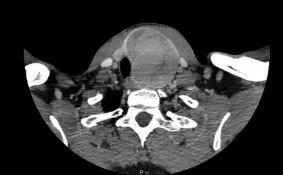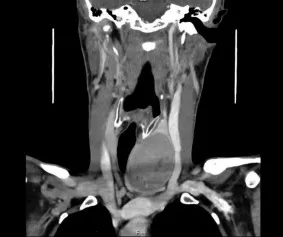Blunt injury to the thyroid gland: A case of delayed surgical emergency
Geraud Galvaing, Julien Brehant Department of Thoracic and Endocrine Surgery, Jean Perrin Comprehensive Cancer Center, Clermont-Ferrand, France Department of Anatomy, Clermont-Ferrand School of Medicine, Université d'Auvergne, Clermont-Ferrand, France
3 Department of radiology, Jean Perrin Comprehensive Cancer Center, Clermont-Ferrand, France
Blunt injury to the thyroid gland: A case of delayed surgical emergency
Geraud Galvaing1,2, Julien Brehant31Department of Thoracic and Endocrine Surgery, Jean Perrin Comprehensive Cancer Center, Clermont-Ferrand, France2Department of Anatomy, Clermont-Ferrand School of Medicine, Université d'Auvergne, Clermont-Ferrand, France
3Department of radiology, Jean Perrin Comprehensive Cancer Center, Clermont-Ferrand, France
Dear editor,
Blunt trauma to the thyroid gland is a possibly lifethreatening condition known for years. However, only few cases have been reported in the English-language literature, so that no consensus has emerged as to its workup or management.
These injuries are often associated with significant airway obstruction requiring emergent endotracheal tube intubation, surgical removal of the hematoma and control of the hemorrhage from the thyroid as well.
Pre-existing thyroid lesions like goiter, cysts or adenoma are thought to render the thyroid more fragile and prone to injury.[1,2]
We report the case of a thyroid hematoma of a previously normal gland requiring delayed surgical treatment. This case report was approved by our institution review board, which waived individual consent.
CASE
A 31-year-old man underwent a low-velocity motorcycle accident, falling over his left shoulder. He was then admitted to the nearest hospital for medical evaluation. At that time, his vital signs were stable without evidence of respiratory distress nor dysphagia and dysphonia. Physical exam was noticed to be normal except a deformity of the left shoulder. Roentography revealed a fracture of the middle third of the left clavicle without any vascular or neurologic deficit. Orthopedic treatment was advised. The patient was discharged from the hospital a few hours after the initial trauma and returned to his home.
Six weeks later, the patient visited his family physician because of persistent swelling of the left side of his neck. When questioning the patient, it appeared that the swelling was already present in the hours following the trauma, but was not noticed on the initial medical evaluation. As the patient remained in perfect health, he did not seek medical assistance before, but he now felt uncomfortable especially when buttoning his shirts. Physical examination confirmed the obvious swelling at the base of the left side of the neck. The patient's voice was not modified; he did not experience dyspnea or dysphagia.
Due to the size of the swelling, the patient was referred to our clinic 10 weeks after the trauma.
Contrast-enhanced computed tomography (CT-scan) was obtained 12 weeks after the initial trauma and revealed a large homogenous hematoma (61×49×80 millimeters) of the left lobe of the thyroid gland without any active bleeding (Figures 1, 2). This hematoma had a mass effect over the cervical portion of the trachea. Plans with the trachea and the other surrounding structures seemed respected. Thyroid hormone levels were normal.A left thyroidectomy was scheduled and performed.

Figure 1. CT-scan revealing the large hematoma of the left lobe of the thyroid gland and the compression of the trachea (arrow).

Figure 2. Coronal view of the hematoma of the left lobe of the thyroid gland (arrow).
The operating-time was 60 minutes and the patient was discharged from our department on post-operative day one after an uneventful stay.
The fi nal pathologic exam showed a large hematoma inside a normal left lobe of the thyroid without histologic fi ndings of adenoma or cyst.
DISCUSSION
Isolate thyroid hematoma is a rare complication of blunt trauma. It could be under diagnosed on stable patients who don't develop respiratory distress or hoarseness like the reported patient. It tends to be more frequent on previously pathologic thyroid gland.However this injury has been reported with normal thyroid glands.[3]
A classification of blunt thyroid injuries has been proposed by Heizmann et al[4]in 2006: similar to Moore's classification system for parenchymatous organs, they proposed a 4-grade injury scale based on CT-scan exploration of the neck.
It is now admitted that low-grade thyroid injury occurring on stable patient with no associated comorbidity does not require surgical exploration of the neck. Close monitoring, daily sonographic follow-up and conservative treatment are considered the treatment of choice. Given the rarity of the condition, it's diff i cult to recommend the duration of follow-up. However, Chartier et al[5]reported a 75-year-old lady who developed respiratory distress from a hematoma as late as 33 hours after initial trauma.
Respiratory distress, dysphagia, hoarseness and/or a pre-existing thyroid condition would require emergent orotracheal intubation and surgical neck exploration.
Transient hyperthyroidism and thyroid storm have been reported after traumatic hemorrhage into a previously normal thyroid gland; it has to be kept in mind especially for patients suffering from ischemic cardiomyopathy.
CONCLUSION
To the best of our knowledge it is the first reported case of a hematoma of the thyroid gland that did not resolve spontaneously after conservative treatment.Hemi-thyroidectomy was performed to release patient's discomfort and tracheal compression. Prolonged followup should be mandatory to ensure complete recovery after such trauma.
Funding: None.
Ethical approval: Not needed.
Conflicts of interest: The authors declare that there are no conf l icts of interest relevant to the content of the article.
Contributors: Galvaing G proposed the study and wrote the fi rst draft. All authors read and approved the final version of the paper.
1 Blaivas M, Hom DB, Younger JG. Thyroid gland hematoma after blunt cervical trauma. Am J Emerg Med. 1999;17(4):348–50.
2 Oka Y, Nishijima J, Azuma T, Inada K, Miyazaki S, Nakano H, et al. Blunt thyroid trauma with acute hemorrhage and respiratory distress. J Emerg Med. 2007;32(4):381–5.
3 Weeks C, Moore FD Jr, Ferzoco SJ, Gates J. Blunt trauma to the thyroid: a case report. Am Surg. 2005;71(6):518–21.
4 Heizmann O, Schmid R, Oertli D. Blunt injury to the thyroid gland: proposed classif i cation and treatment algorithm. J Trauma.2006;61(4):1012–5.
5 Chartier LB, Turner JP. Delayed intrathyroidal hematoma causing respiratory distress after a seemingly benign fall: a case report. Int J Emerg Med. 2010;3(4):431–3.
Accepted after revision May 16, 2017
Geraud Galvaing, Email: Geraud.galvaing@clermont.unicancer.fr
World J Emerg Med 2017;8(3):234–232
10.5847/wjem.j.1920–8642.2017.03.012
January 18, 2017
 World journal of emergency medicine2017年3期
World journal of emergency medicine2017年3期
- World journal of emergency medicine的其它文章
- A case of exercise induced rhabdomyolysis from calf raises
- Instructions for Authors
- Iatrogenic Horner's syndrome: A cause for diagnostic confusion in the emergency department
- Ocular mutilation: A case of bilateral self-evisceration in a patient with acute psychosis
- Validation of different pediatric triage systems in the emergency department
- Association of post-traumatic stress disorder and work performance: A survey from an emergency medical service, Karachi, Pakistan
